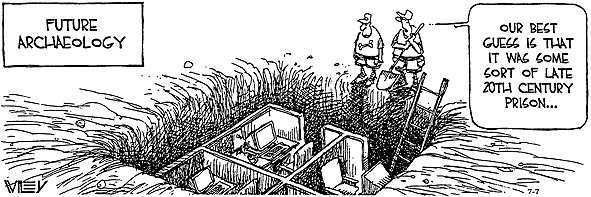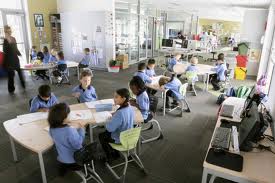Larry Cuban on School Reform and Classroom Practice: Open Space Offices and Open Space Schools: Corporate Influence on Educating U.S. Students?
Some viewers and friends ask me from time to time where have I gotten ideas for writing twice-weekly posts about school reform and classroom practice since 2009. I tell them that I read lots of blogs, magazine articles, and curated websites written by teachers, administrators, school board members, historians of education, and state and federal policymakers. I listen to current and former graduate students who stay in touch with me. And then there are films I watch, magazines and books I read, and friends and family I talk with every week where schooling, policy, and classroom teaching are completely absent.
Then I remind viewers and friends that I was a high school social studies teacher for 14 years in Cleveland (OH) and Washington, D.C., central office administrator in the latter district for two years, and served as superintendent for seven years in Arlington (VA), a district across the river from the District of Columbia. Then for 20 years I was a university professor and researcher who visited classrooms in various states and wrote frequently about what I observed.
From all of these writings, conversations, and experiences I get ideas and jot them down on post-its or scraps of paper or create PDFs as reminders for possible posts. I think about each one, scratching out some entries on post-its and deleting PDFs but keeping a few. More often than not, I consider how “new” ideas, innovations, popular policies, and classroom practices have a history that often goes unnoted.
And that is how I came to write about the linkages between corporate open space offices and the 1960s-1970s innovation of open space schools.
Connecting Corporate Cubicles and Open Space Schools
Some time ago, I saw an article criticizing open space in offices, the open areas filled with cubicles for employees that began in the U.S. and Europe in the 1950s , accelerating in the 1960s and since have become so widespread (70 percent of all office space is open) as to be satirized in Dilbert and “The Office.”



After reading the article (and similar ones–(see here and here), I noted the dates for introducing open space offices and thought about the architectural innovations in schools–called “open space”–that swept across U.S. schools in the late-1960s through the late-1970s. I asked myself: with all of the influence that business practices have had on schooling historically, are open space schools another instance of that influence? I was curious and began–you guessed it–researching it on the Internet. I did find one writer who made the explicit connection between open space offices and schools. No others could I find.
Keep in mind, however, that open space schools are not identical with “open classrooms,” a pedagogical innovation aimed at classrooms in both traditional age-graded school buildings as well as in those newly-built open space schools.
Still, open space schools, like “open classrooms,” did have (and still does) a progressive pedagogical ideology that led to creating large spaces for groups to assemble, cubicles for small group and individual activities with few traditional classrooms with four walls. No hallways either.
Progressive-minded educators wanted to liberate teachers from traditional instruction in self-contained classroom buildings that architecturally looked like egg-crates. They wanted open space for small group activities, team-teaching, multiple learning centers for young children, student-driven projects for youth, and frequent collaboration among both teachers and students. Open space schools, these advocates said, would make “frontal teaching“disappear.


Criticism of open space schools, however, arose in the 1970s from teachers, parents, and administrators about the noise and distractions that accompanied lessons taught cheek-by-jowl in open spaces. Many students and teachers found it hard to manage activities that required team-work, collaboration, and independence. Within a few years, teachers and administrators had erected bookcases and sliding partitions to re-create self-contained classrooms. Over time, open space buildings were demolished to be replaced with new ones containing, yes, you know what I will write next: “egg-crate” classrooms and corridors.
And what about open space offices? One writer who summarized research on the psychological ill effects of open space upon office worker performance, said: “… [Open space and cubicles] were damaging to the workers’ attention spans, productivity, creative thinking, and satisfaction.” Such effects were very close to what teachers, embedded in open space schools, said decades ago.
Back to my original query: with all of the influence that business practices have had on schooling historically, are open space schools another instance of that influence? Yes, it is. That corporate influence, however, is not new; it has been around for well over a century(see here and here).
The point I make is that business influence on school organization, structure and use of space has a long history and those innovative, highly touted open space schools that mushroomed across the nation decades ago and have largely disappeared in the 2020s has been another example of that influence.
This blog post has been shared by permission from the author.
Readers wishing to comment on the content are encouraged to do so via the link to the original post.
Find the original post here:
The views expressed by the blogger are not necessarily those of NEPC.
